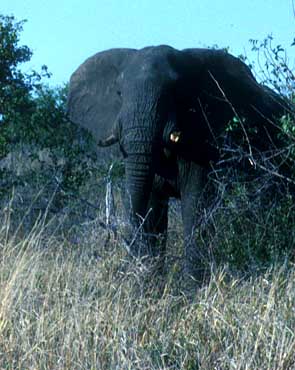
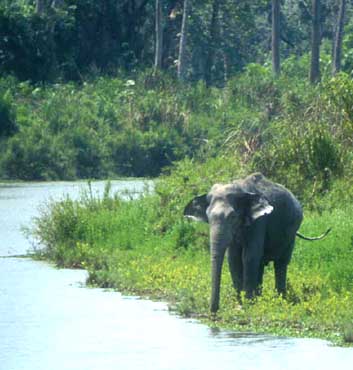
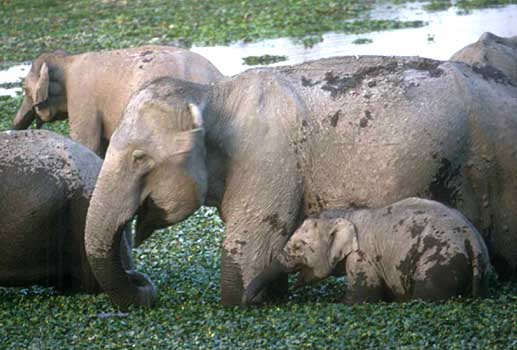 Elephants are in their own Order [Proboscidea] which has but a single living
family [Elephantidae] but there are fossil elephant ancestors in various
families going back 38 million years that include within the lineage the
huge mammoths of the Pleistocene. Today's living elephants are the largest
land mammals on earth. To quote Barnes (1985) "Elephants have always been
regarded with awe and fascination, mainly because of their great size and
because of their trunk and formidable tusks, but also because of their
longevity, their ability to learn and remember, and their adaptability
as working animals. For millennia, their great strength has been exploited
in agriculture and warfare and even today, notably in the Indian subcontinent,
they are still important economically and as cultural symbols." And in
some Indian parks the visitor may take "elephant rides" into the forest
on a domesticated elephant in search of tigers and adventure.
Elephants are in their own Order [Proboscidea] which has but a single living
family [Elephantidae] but there are fossil elephant ancestors in various
families going back 38 million years that include within the lineage the
huge mammoths of the Pleistocene. Today's living elephants are the largest
land mammals on earth. To quote Barnes (1985) "Elephants have always been
regarded with awe and fascination, mainly because of their great size and
because of their trunk and formidable tusks, but also because of their
longevity, their ability to learn and remember, and their adaptability
as working animals. For millennia, their great strength has been exploited
in agriculture and warfare and even today, notably in the Indian subcontinent,
they are still important economically and as cultural symbols." And in
some Indian parks the visitor may take "elephant rides" into the forest
on a domesticated elephant in search of tigers and adventure.
Wild Indian Elephants Elephas maximus (above or left; a mother and calf in a small herd in Kaziranga NP, Assam, India in Apr 2001) are now an Endangered species. Although they range from India to Indonesia less than 50,000 now exist in the wild where they are usually elusive, unpredictable, and dangerous to approach. We recently had wonderful experiences with them from open jeeps in Corbett and Kaziranga but also encountered a belligerent mother protecting her calf. They are powerful enough to uproot trees or demolish a car,
I learned as a child how to separate African elephants from Indian elephants and therefore was quickly disappointed with Hollywood movies that featured the wrong species. Tarzan movies invariably showed him in "Africa" riding Indian Elephants. Elephants in Africa (below left; Kruger NP, South Africa, July 1996) have huge ears compared to elephants from India (below right in Kaziranga NP, India, April 2001). Indian Elephants (above and far right) also have convex backs (not concave or sway-backed like those in Africa) and only one lip on the truck (those in Africa have two lips on the trunks). The elephants in Africa also have larger tusks and tusks occur on adults of both sexes; the very small tucks of adult female Indian Elephants are not visible in the field.
Of course it is the ivory tusks that have been the recent downfall of elephants, especially in east and southern Africa. Over 100,000 elephants a year were killed in Africa by poachers during the 1970s and 1980s and their numbers plummeted. In some parks they were nearly wiped out; the dramatic story of the fight to stop poaching in North Luangwa NP, Zambia, is told by Mark & Delia Owens in Eye of the Elephant. Males with huge tusks (even as large as the one below photographed in Samburu NP, Kenya, back in Nov 1981) are now very rare. In some parks in South Africa tusks were sawed off (above left) in an attempt to stop poaching.
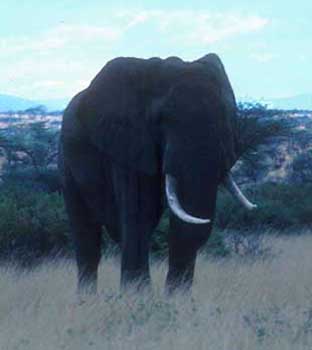 Recent biochemical evidence shows that there are actually two species of
elephants in Africa that are as distinct from each other genetically as
lions are from tigers. All my photos of elephants in Africa (above left,
directly left, and below ; the bottom group was in Masai Mara NP, Kenya,
in Nov 1981) are of Savanna Elephant Loxodonta africana.
The Savanna Elephant ranges across the east and south African veldt; the
recent population estimate is 350,000. These are the "classic" African
Elephants of the game parks: wild, unbelievably huge, and dramatic.
Recent biochemical evidence shows that there are actually two species of
elephants in Africa that are as distinct from each other genetically as
lions are from tigers. All my photos of elephants in Africa (above left,
directly left, and below ; the bottom group was in Masai Mara NP, Kenya,
in Nov 1981) are of Savanna Elephant Loxodonta africana.
The Savanna Elephant ranges across the east and south African veldt; the
recent population estimate is 350,000. These are the "classic" African
Elephants of the game parks: wild, unbelievably huge, and dramatic.
In the deep forests of central and west Africa lives a second species, the Forest Elephant Loxodonta cyclotis. It is decidedly smaller than Savanna Elephant and much more difficult to see in its heavily-wooded habitat. I have seen small groups at dawn or dusk at the edge of the forest in La Lopé Reserve, Gabon, in July 1996, but the conditions were not conducive to photography.
Elephants of any species are fascinating. They live to 50-60 years old in the wild (and to 80 years in captivity) in matriarchal societies. The Savanna Elephant has been especially well studied and much information is available in the popular literature (e.g., National Geographic) or on TV nature shows. Elephants are popular attractions at zoos. But nothing compares with encountered an elephant in its home territory in the wilds of Africa or Asia. They are among the highlights of any trip to those areas.
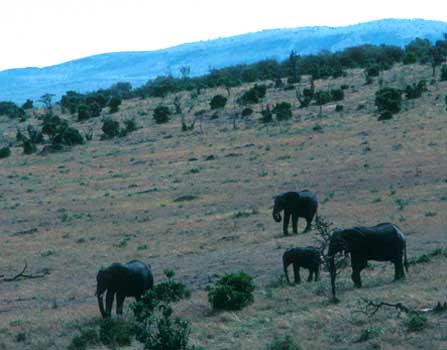
PHOTOS: All photos on this page are © 2001 Don Roberson; all rights reserved.
Literature cited:
Barnes, R. F. W. 1985. "Elephants" in The Encyclopedia of Mammals (D. W. Macdonald, ed.). Facts on File Press, New York.TOPOwens, M., and D. Owens. 1989. Eye of the Elephant. Houghton Mifflin, Boston.